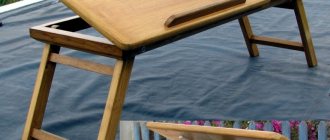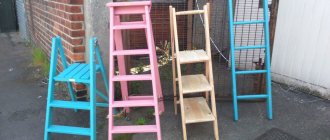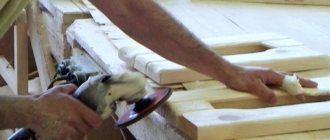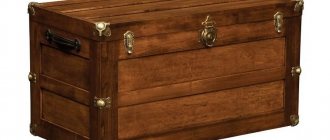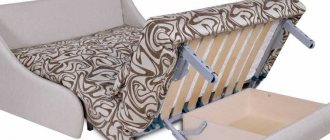Furniture assembled according to the principle of a transformable designer is in high demand among people accustomed to the constantly changing rhythm of life. These furniture samples can be used for a variety of purposes, therefore they are considered universal. As for easily transformable seats, the optimal solution is a collapsible step stool. You can buy it at a furniture store, but it’s much more interesting and enjoyable to make it yourself.
Design features of the model
A step stool is most often made of wood. The design looks like a traditional chair, but if necessary, it can be transformed into a convenient ladder, which allows you to get things from high shelves, change burnt out light bulbs, or carry out minor repair work. A piece of furniture consists of front and back sides, a seat, a back, and steps. Main features of the product:
- compact dimensions;
- no need for additional support;
- ease of movement from place to place;
- ability to withstand impressive weight without loss of stability;
- quick transformation into a staircase.
The seat reclines easily and can be used as a step. The dimensions and weight of the structures are larger compared to standard furniture. In private houses and spacious apartments, this nuance is not particularly important. In conditions of limited space, you will have to allocate a separate place for storing furniture.
The main advantages of such chairs are versatility of use, safety, and convenience. Initially, the designs found application in libraries, as they made it possible to reach the top shelves. Subsequently they became much more widespread.
The appearance of folding stepladder chairs is varied. The surface is painted in different colors and decorated with carved elements and patterns.
Classification
Today, practical ladder-shaped chairs are used in office and residential spaces. Products are classified according to material of manufacture, type of construction, and dimensions. To choose a suitable model, you need to pay attention to all these parameters.
According to the material of manufacture
For the production of folding stepladder chairs, three main types of raw materials are used. The structures can be wooden, metal, or made from chipboards. Each option has its own characteristics:
- Wood is an expensive, durable material of natural origin; with proper care it will last for many years. In most cases, pine or birch is used to make chairs, but other species are also suitable: beech, oak, acacia. The latter are more expensive, and their correct processing at home is only possible with carpentry skills.
- Chipboards. They are used to make seats, steps, backrests, and, less commonly, legs. The combination of panels with natural wood allows you to create reliable structures that are optimal in terms of cost and complexity of work.
- Metal. Characterized by increased strength and durability. To assemble the chairs, stainless steel and aluminum are used, which are less susceptible to corrosion. Assembly can be carried out by craftsmen who have the skills to work with similar materials and a welding machine.
Plastic furniture is also common today and can be purchased ready-made. Products are affordable, but have a limited service life. Plywood structures are cheaper and lighter compared to natural wood or wood-based materials, but are inferior in strength. The maximum load for the chair is no more than 80 kg.
Rules for choosing a kneeling chair, step-by-step DIY production
Tree
Chipboard
Metal
By type of design
There are several types of folding chairs. The products differ in design features, transformation options, and appearance. You can make the following models yourself:
- Step stool. The simplest furniture takes up a lot of space and looks somewhat primitive. The product is equipped with one seat and 2–3 steps, which can be folded or extended if necessary. The model is used as a chair or cabinet, installed in the kitchen or bedroom.
- Transformable chair. The main feature of such furniture is that after reclining the seat, a small full-fledged staircase is formed. Externally, the design resembles a traditional chair, the difference lies in the presence of several steps hidden at the bottom.
- Transformable staircase. It looks like an ordinary high stool, sometimes with a back. The steps extend and retract along guides. The model is easy to use, mobile, suitable for rooms with limited space.
The design of the step stool can be folding or stationary. The former are compact in size, but the latter are more durable and reliable. Models that are installed in a specific place and do not move are used as stands for various objects or pots with indoor plants.
Step stool
Transformable chair
Transformable staircase
Folding
Stationary
By size
In order to properly make a transforming chair with your own hands, you need to clarify the standard dimensions of the products. Optimal parameters for a high step stool:
- 4 main legs: 19 × 100 × 725 mm;
- 4 middle legs: 19 × 100 × 470 mm;
- 2 small legs: 19 × 10 × 215 mm;
- 2 bottom bars: 19 × 100 × 420 mm;
- 2 top bars: 19 × 38 × 180 mm;
- 2 side covers: 305 × 170 × 250 mm;
- 2 stages: 19 × 180 × 298 mm;
- 2 crossbars: 19 × 100 × 400 mm.
You will need to prepare a pair of upper and lower drawers. The dimensions of the first are 19 × 125 × 345 mm, the second - 19 × 105 × 345 mm. Transforming stairs are created based on the following parameters:
- 6 strips: 20 × 20 × 95 mm;
- 3 back panels: 20 × 50 × 400 mm;
- 3 steps: 20 × 120 × 360 mm;
- 2 front sides: 20 × 270 × 400 mm;
- 2 rear sides: 20 × 325 × 850 mm;
- front seat: 20 × 90 × 400 mm;
- rear seat: 20 × 165 × 400 mm.
The step stool is complemented by 2-3 steps, located at a distance of 21 cm from each other. The shape of the supports resembles the letter A due to the characteristic arrangement of the slats connected to the crossbars. The angle of inclination of the drawer and legs should be 80º.
Types of stepladder chair
Folding stairs can be presented in several types, let's look at them:
- a high step stool looks like a tall stool with pull-out steps;
- the transforming chair consists of three steps, and when folded it looks like a regular chair;
- the transforming staircase includes steps that move out using guide runners for drawers;
- step stool with a screw module for extending steps.
Transformers in appearance are not much different from ordinary chairs with backs. Such furniture can easily and harmoniously fit into any interior.
Working with a drawing
You can make a folding stool yourself or purchase a finished product. The purchase is not always financially affordable, so craftsmen with experience in carpentry prefer to create practical designs with their own hands. The procedure is simplified thanks to a large number of ready-made diagrams with a detailed description of the manufacturing process.
The design of the chair will depend on the type of design and materials used. It is necessary to clarify the purpose of the product. Based on this, wooden, chipboard or metal blanks, as well as suitable tools, are prepared for the work.
To make furniture yourself, you will need drawings with dimensions including general views, assemblies, and sections. The diagrams use special symbols that must be read correctly. The lines in the drawing are deciphered as follows:
- Solid thick ones are contour lines depicting a piece of furniture.
- Solid thin - used to indicate parameters.
- External thin ones - specify part numbers.
- Dotted - used to demonstrate elements that are not visible from a certain angle.
- Dash-and-dotted lines are center lines showing the middle of the furniture.
- The intersections of 2–3 center lines reflect the centers of round parts.
Tips for making and decorating plywood chairs with your own hands
In furniture drawings, all dimensions are indicated in millimeters and are given in actual size, regardless of the scale of the diagram. The parameters of each element are reflected taking into account the length of the spikes. Capital Russian letters indicate the arrows of the cuts, and Roman numerals indicate the nodes.
In the drawings of step-chairs, each element is drawn in detail. Detailing is carried out - drawing structural parts, determining their sizes. This is a creative process, not just copying images. Using ready-made diagrams, you can make all the panels and drawers to order.
Tools and consumables
We will need the following tools:
- hacksaw (optionally, a circular saw);
- jigsaw (preferably electric);
- screwdriver;
- grinder and a circle for stripping wood;
- hammer;
- sander;
- self-tapping screws;
- brushes and varnish (optionally, paint, stain) for final finishing.
As a source material, experts advise using multilayer plywood (at least twelve millimeters thick). If the base is thicker, then, undoubtedly, the product will become stronger, but its “weight category” will increase. But we advocate a compact and not too bulky design. A small clarification: when you plan to use it not only indoors, but also outdoors, you need to choose a moisture-resistant version of the plywood sheet.
You can sit and take a break
Step-by-step manufacturing algorithm
Making your own ladder stool is an interesting creative endeavor. The manufacturing algorithm includes the preparation or selection of drawings, preparation of materials and tools, production, assembly of workpieces and finishing. Step-by-step master classes will help you complete all the steps correctly.
Transformer
Practical multifunctional furniture can be made from wood with your own hands. Pine or ash is used as the main material. To work you will need the following elements:
- 2 side panels, for chair and footrest;
- seat base;
- turning step;
- backrest rail;
- steps.
From the tools you need to prepare wood drills, a drill, a grinder, from consumables - screws, self-tapping screws, guides, hinges. After preparing the drawing, all elements of the transformable staircase chair are cut out from the selected material and carefully polished. All actions are based on the instructions:
- Perform markings and chamfers at the bottom of the sidewall.
- Cut out the inner and outer contours of the element.
- The drawing is transferred to wooden blanks.
- The end parts of the sidewalls are ground, the sharp edges are processed with a milling cutter.
- The back is made in the same way as the sides.
- For assembly, the middle step is glued and fixed with self-tapping screws.
- Secure the steps and seat.
- The two finished parts of the structure are connected with a piano loop.
All screws are covered with wood putty, and the surface of the product is sanded. At the final stage, the finished stool is painted in the chosen color or varnished.
Professional furniture assemblers do not recommend using only glue without screws to fix elements - the structure will be unstable and fragile.
Mark and chamfer the bottom of the sidewall
Cut out the inner contour of the side panel
Cut out the outer contour of the side panel
Transfer the drawing to wooden blanks and repeat the procedure with the remaining parts of the chair
Sand the end parts of the sidewalls
Make the back in the same way as the sides
Prepare parts for installation
Glue the middle step and secure it with screws
Make markings for the seat
Attach steps to stepladder
Secure the seat
Putty all the screws and sand the entire structure
Fasten the two parts together with a piano loop of the appropriate length
Paint the wooden structure in the desired color or coat it with a protective agent
Ready-made transforming chair
High step stool
To work, you will need blanks for steps and a chair: crossbars, large and small legs, drawers and other elements. The tools you need to prepare are a screwdriver, a grinder, and a drill. The manufacturing process takes place step by step:
- All workpieces are carefully sawed and polished.
- Assembly involves parallel positioning of the legs at an angle of 10º. The ends of the plywood overlay and the crossbars should not diverge.
- If dowels are used to fix elements, grooves are first prepared for them.
- The drawers are cut at an angle of 80º.
- A couple of cuts are made on the bottom step for an accurate connection to the legs.
- The crossbars are attached to the base, the drawers - to the top step. Screws are used in the work.
- The middle legs are fixed with dowels, the front drawer and steps are assembled.
After assembly, the high transforming stool is installed in a suitable place and the guide is screwed on. The structure is carefully inspected for defects. If no defects are found, the product is dismantled and then reassembled using glue.
Shapes, materials and designs of stool covers, methods of attaching them
Stool diagram
Make all the elements to connect the structure
Assemble the seat
Prepare the support part for assembly
Connect elements using dowels
Measure the location of the steps and make recesses with a router
Secure the slats to connect the support post and the ladder at one end, and secure the other ends in the middle of the support posts
Ready-made step stool
Ladder chair
To make such models, it is necessary to prepare the main elements from wood or chipboards. You will need side and back walls, a seat, a pair of bases and supports, and 4 cross bars. The tools and consumables you need are a screwdriver, a grinder, a drill, as well as self-tapping screws and a piano hinge. The work is carried out according to the instructions:
- First of all, they select or draw up drawings for making a chair with their own hands, and all the elements are cut out from them.
- The parts are polished, sharp corners and edges are smoothed.
- For assembly, the sides of the product are connected.
- Installation of the base and steps is carried out using a piano hinge.
When making furniture from wood with your own hands, you need to take care to carefully smooth out pointed edges and corners. The procedure will help extend the life of structures. Sharp ends can break when exposed to high loads.
Cut out parts, sand sharp corners and edges
Glue all the elements of the steps
Fasten the elements to each other, and then fix the resulting structure to the stool
Ready product
Ironing board stool
In recent years, a variety of additions have been used in the production of a wooden transformable stepladder chair with your own hands. An ironing board built into the back will help increase the functionality of the furniture. For work you will need blanks cut from pine beams, as well as plywood. Tools required include a circular saw, drill, drills, jigsaw, plane, and grinder. Do-it-yourself transformable stepladder chair is assembled in stages:
- They select a ready-made one or create an individual drawing with measurements.
- The necessary elements are cut out from suitable materials.
- The parts are assembled together using connecting rails. The ironing board is attached to the backrest.
After assembly, the DIY staircase chair is carefully sanded to obtain a perfectly smooth surface. Then the product is painted, varnished or decorated by any available means. For the ironing board itself, a durable fabric cover is sewn, under which a thick layer of foam rubber is placed.
From the pipe
If there are fragments of a profile pipe left from welding any metal structure, you can put them to use - build a step-ladder chair with your own hands.
- Using a grinder, we cut the profile into parts so that the base can be welded. We will weld the frame at an angle of 45 - for comfort in climbing stairs.
- We make the frame of the bench at an angle of 90 degrees (see picture below).
- We cover the finished frame from the profile pipe with black paint (it is better to do this twice, drying each layer thoroughly).
- We construct steps with a seat from a plank pallet (from under blocks or bricks). We cut out the elements using a jigsaw in accordance with the dimensions of the welded structure.
- We fasten the parts from the board with self-tapping screws, covering the steps with the seat with furniture varnish (2 layers are desirable). Ready to use!
Stages of production from a profile pipe
Photo gallery
Finishing
Over time, even the most high-quality furniture loses its performance characteristics and attractive appearance. To extend the service life, the surface of the step stool is treated with special compounds. These can be antiseptic impregnations with water-repellent properties, varnish, drying oil, stain, or coloring mixtures.
Furniture that will be used daily is coated with a triple layer of varnish. The rotating elements are coated with oil for quick and easy conversion to a stepladder and vice versa.
A stepladder chair created by yourself will become a unique addition to the interior if you use a variety of decor to enhance the aesthetic properties of the product:
- artistic painting;
- decoupage;
- applications.
Before creating the decor, you must carefully polish the surface of the chair. To do this, use sandpaper or a grinding machine. To preserve the natural wood structure, the furniture is coated with primer and then with clear varnish. The decoupage technique allows you to fit designs into any interior.
Products with an aging effect are popular. To create it, furniture is evenly coated with metallic-colored paint. The steps are treated with a white compound and decorated with drawings. After this, rice paper with the selected pattern is used. It is applied to the structure and coated with glue. After drying, sand it with sandpaper.
The original transforming chair will always be in demand due to its practicality and functionality. Compact furniture will organically complement the dining table, facilitate construction work, and take on the function of a stylish design element. Models made by yourself will last longer if production techniques are followed and proper care is taken during use.
Artistic painting
Decoupage
Application
What tools are needed
In addition to materials, you will also need tools. Some of the tools will be needed for the production and assembly of the main elements, and some will be needed to create the decor and design of the chair.
Use only professional tools.
Basic tools:
- Hacksaw.
- Drill with a set of drills.
- Self-tapping screws.
- Glue.
- Plane.
- Piano hinges for stairs.
- Guides for the retractable mechanism.
- Clamps.
- Sandpaper.
- Graph paper.
Such a tool can be successfully used during construction and repair work.
Additionally, you may need an electric jigsaw and various types of hacksaws. Using these tools you can beautifully decorate the sides of a chair or the back.




